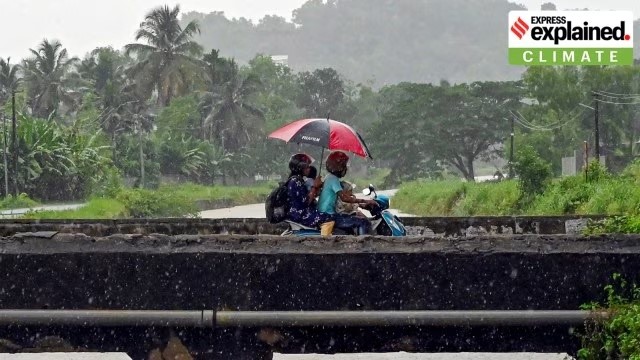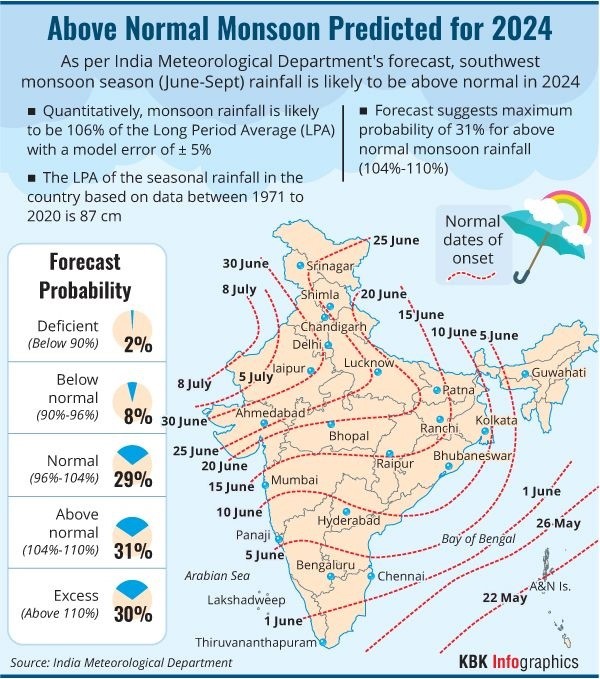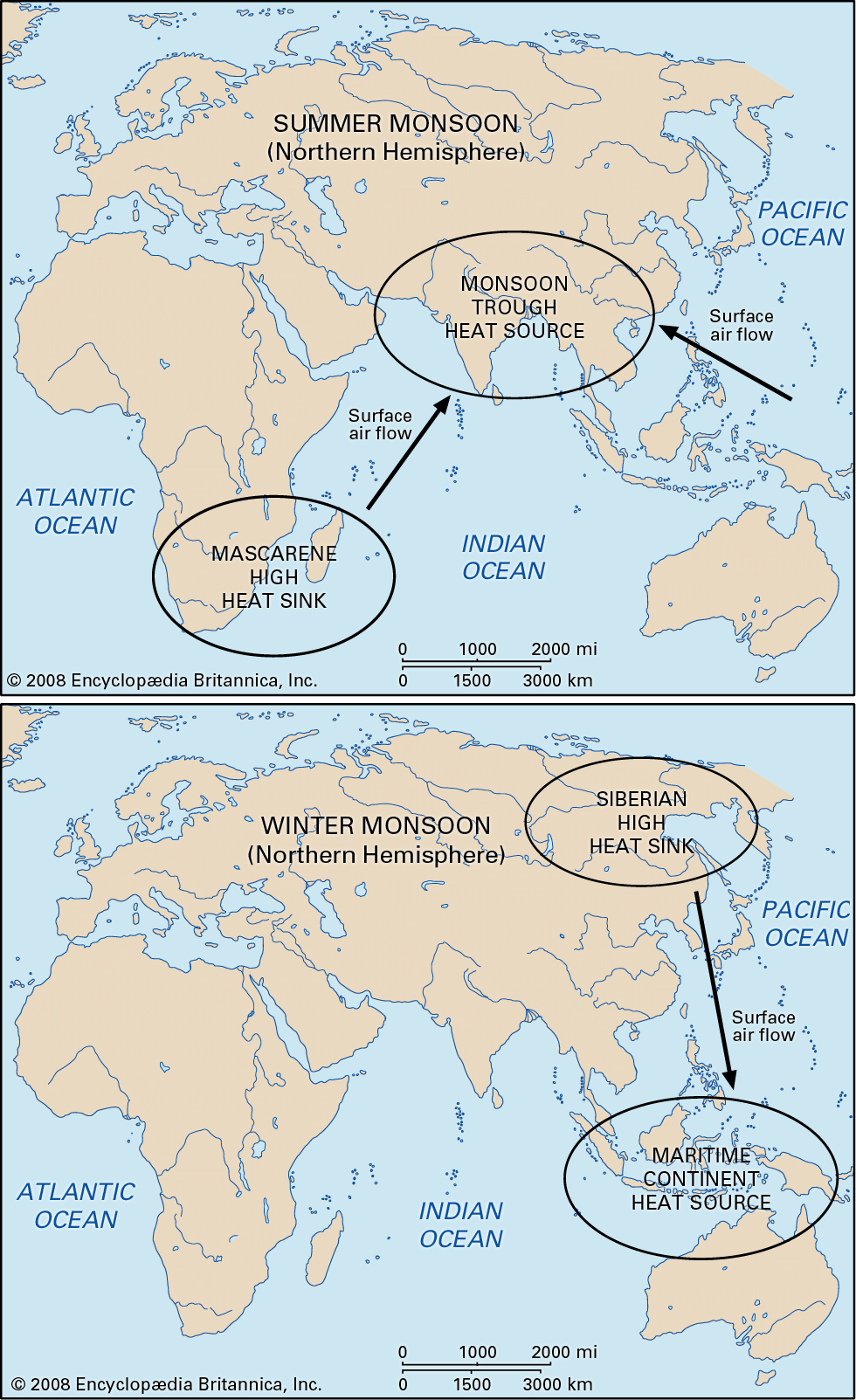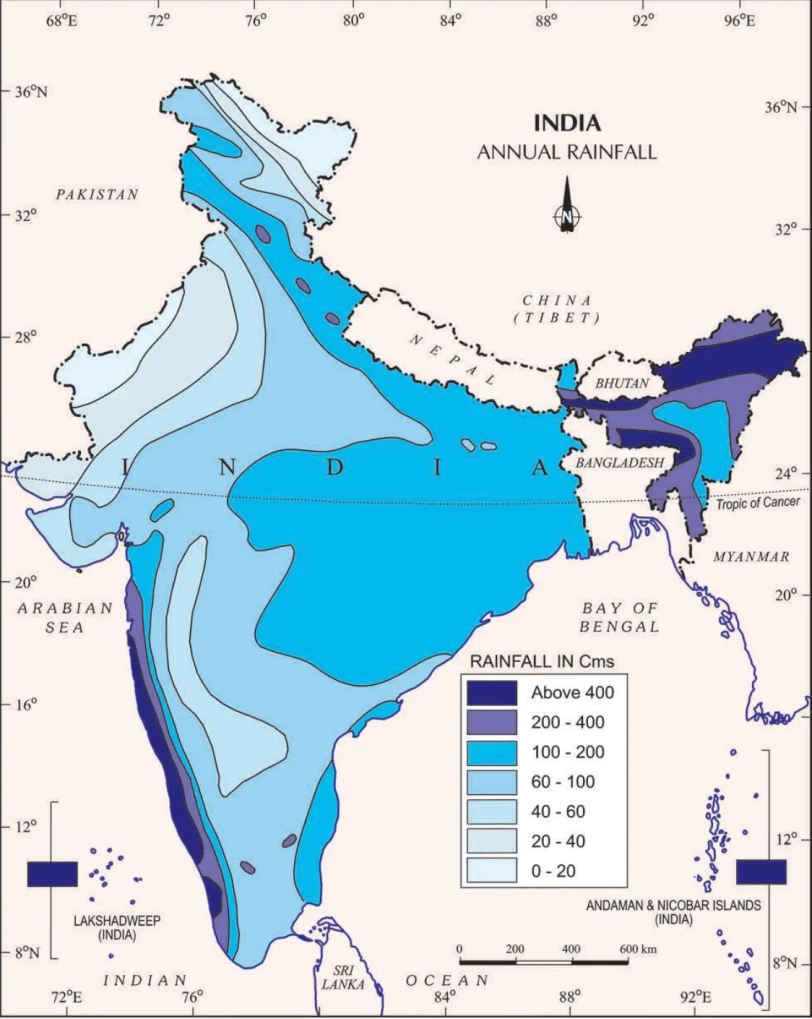
Copyright infringement not intended
Picture Courtesy: https://indianexpress.com/article/explained/explained-climate/onset-monsoon-9356716/
Context: The onset of the monsoon over Kerala marks the beginning of the four-month, June-September southwest monsoon season in India, which brings over 70% of the country's annual rainfall.
Details
- The Indian Meteorological Department (IMD) determines the onset of the monsoon based on specific and measurable parameters established in 2016. These parameters include rainfall patterns, wind conditions, and atmospheric heat distribution.
Criteria used by the IMD to declare the onset of the monsoon:
- Rainfall: The IMD considers rainfall data from 14 designated meteorological stations in Kerala and Lakshadweep. The onset is declared if at least 60% of these stations record a minimum of 2.5 mm of rain for two consecutive days after May 10. Once this criterion is met, and specific wind and temperature conditions are fulfilled, the onset over Kerala is officially declared.
- Wind Field: The depth of westerlies (prevailing winds blowing from the west at mid-latitudes) should extend up to 600 hectopascals (hPa) within a specified geographical area.
- Heat: The INSAT-derived Outgoing Longwave Radiation (OLR) value, which measures the energy emitted to space by the Earth's surface, oceans, and atmosphere, should be below 200 watts per square meter (wm2) within a designated area bound by 5-10ºN latitude and 70-75ºE longitude.
|
While the Andaman and Nicobar Islands generally experience monsoon rainfall between May 15 and May 20 each year, and rainfall along the Kerala coast usually begins in the last week of May, the official declaration of the monsoon onset is dependent upon the fulfilment of the conditions outlined above.
|

Indian Monsoon
- The Indian monsoon is one of the most significant weather phenomena globally, impacting India and its surrounding regions.
- The formation of the Indian Monsoon is a complex process driven by a combination of geographical features, oceanic conditions, and atmospheric dynamics.
Formation of the Indian Monsoon
High Heating over Indian Landmass
- During the summer months, the Indian subcontinent experiences intense heating due to its position near the equator. As the sun's rays strike the land, the surface temperatures rise significantly, creating a region of low pressure over the Indian landmass.
- This high heating is a result of the tilt of the Earth's axis, which causes the sun's rays to be more direct over the Indian subcontinent during the summer season.
Low-Pressure Area Formation
- The intense heating over the Indian landmass leads to the formation of a large area of low pressure, known as the thermal low. Low pressure occurs because the warm air near the surface rises, creating a zone where air pressure is relatively lower compared to the surrounding regions.
- This low-pressure system acts as a crucial factor in attracting moisture-laden air masses from surrounding regions, setting the stage for the development of the monsoon.
Attraction of Southeast Trade Winds from Southern Oceans
- The presence of the thermal low over the Indian subcontinent creates a pressure gradient that drives the movement of air masses.
- In response to the low pressure over land, moist air from the southern Indian Ocean, driven by the southeast trade winds, begins to move towards the Indian subcontinent.
- These southeast trade winds are characterised by their moisture content, as they have travelled over warm ocean waters, picking up moisture along the way.
Convergence of Winds towards Indian Subcontinent
- As the southeast trade winds approach the Indian subcontinent, they converge with other air masses, including the southwest winds from the Arabian Sea and the Bay of Bengal.
- The convergence of these moisture-laden air masses creates a region of intense uplift and instability in the atmosphere, leading to the development of convective clouds and rainfall.
Formation of Southwest Monsoon
- The convergence of winds and the presence of the thermal low result in the establishment of the southwest monsoon over the Indian subcontinent.
- This monsoon brings heavy rainfall to large parts of India, replenishing water sources, nourishing agriculture, and sustaining ecosystems.
- The onset and duration of the southwest monsoon are critical for the agricultural economy and livelihoods of millions of people across the region.

Impact on Weather
Arrival of Southwest Monsoon
- The onset of the southwest monsoon marks the beginning of the rainy season in India, typically occurring around June and lasting until September.
- The monsoon arrives in two branches: the Arabian Sea branch and the Bay of Bengal branch. These branches gradually advance northward, covering the entire Indian subcontinent over several weeks.
Heavy Rainfall over Windward Sides of Western Ghats and Mountainous Regions
- As the moisture-laden southwest winds encounter the Western Ghats and other mountainous regions, they are forced to rise, leading to orographic lifting.
- Orographic lifting results in the cooling and condensation of air, leading to the formation of clouds and heavy rainfall on the windward side of these mountains.
- The Western Ghats, in particular, receive substantial rainfall during the monsoon, which is crucial for replenishing rivers, lakes, and groundwater sources.
Varied Rainfall Patterns across Different Regions
- The southwest monsoon brings varied rainfall patterns to different regions of India.
- Northeastern India experiences heavy rainfall due to orographic lifting along the Himalayas and the Meghalaya Plateau, leading to high precipitation totals.
- The Ganga Valley and northern plains receive moderate to heavy rainfall, contributing to the fertility of agricultural lands in these regions.
- The Deccan Plateau and parts of southern India receive relatively less rainfall compared to other regions, leading to drier conditions and occasional droughts.
Influence on Temperature, Humidity, and Atmospheric Circulation
- The southwest monsoon significantly influences temperature and humidity levels across the Indian subcontinent.
- The arrival of monsoon rains brings relief from the scorching heat of the pre-monsoon period, leading to lower daytime temperatures. However, increased humidity levels during the monsoon season can lead to muggy conditions, especially in coastal areas.
- The southwest monsoon also plays a crucial role in atmospheric circulation patterns over the Indian Ocean and surrounding regions, affecting weather systems such as tropical cyclones.
Phenomena Associated with Monsoon
Breaks in Rainfall
- Breaks in rainfall refer to periods of temporary cessation or reduction in precipitation during the monsoon season.
- These breaks can occur due to various factors such as the movement of weather systems, atmospheric instability, or the presence of dry air masses.
Movement of Monsoon Trough
- The monsoon trough is a low-pressure area that extends from the Arabian Sea to the Bay of Bengal during the monsoon season.
- Its movement dictates the spatial distribution of rainfall across different regions of India. As the monsoon trough shifts northward or southward, it can bring rainfall to specific areas while leaving others relatively dry.
Wet and Dry Spells
- Wet spells are periods characterised by continuous or heavy rainfall, typically lasting for several days to weeks.
- Dry spells, on the other hand, are periods with minimal or no rainfall, often lasting for a few days or more.
- The alternation of wet and dry spells is a common feature of the monsoon season, reflecting the inherent variability of the weather patterns.
Intermittent Rainfall and Rainless Intervals
- Intermittent rainfall refers to precipitation that occurs sporadically, with periods of rain alternating with periods of dry weather.
- Rainless intervals are periods when no rainfall occurs, leading to prolonged dry conditions.
Tropical Depressions Formation over the Bay of Bengal
- The Bay of Bengal is a hotspot for the formation of tropical cyclones and depressions during the monsoon season.
- These weather systems can bring heavy rainfall and strong winds to coastal regions, contributing to localised flooding and other hazards.
Contribution to Variability in Rainfall Patterns
- The monsoon season is characterised by significant variability in rainfall patterns both spatially and temporally.
- Factors such as the strength and position of the monsoon trough, the influence of weather systems like tropical cyclones, and local topography all contribute to this variability.
Rain Shadow Areas
- Rain shadow areas are regions that receive significantly less rainfall compared to adjacent areas due to the blocking effect of mountain ranges.
- As moist air masses from the Arabian Sea or the Bay of Bengal encounter mountain barriers such as the Western Ghats or the Aravalli Range, they are forced to rise, leading to orographic precipitation on the windward side. The leeward side, or rain shadow region, receives much less rainfall.
Lesser Rainfall despite Monsoon Influence
- Despite being influenced by the monsoon, certain regions experience lesser rainfall compared to others due to various factors such as topography, distance from the coast, and atmospheric conditions.
- Examples include the Deccan Plateau and parts of Rajasthan, which receive relatively lower rainfall despite being under the influence of the monsoon
Regional Variations
Northeast India
- Northeast India, comprising states like Assam, Meghalaya, Nagaland, and Manipur, receives some of the highest rainfall amounts in the country. The region is influenced by the southwest monsoon winds that bring moisture-laden air masses from the Bay of Bengal.
- The presence of the Eastern Himalayas acts as a barrier, forcing the moist air to rise and leading to orographic rainfall on the windward slopes. This results in heavy rainfall in areas such as Cherrapunji and Mawsynram, known as the wettest places on Earth.
Western Ghats
- The Western Ghats, a mountain range running parallel to the western coast of India, significantly influences rainfall patterns in the region.
- Moisture-laden southwest monsoon winds are forced to rise as they encounter the Western Ghats, leading to orographic rainfall on the windward side.
- The windward slopes of the Western Ghats, especially in states like Kerala and Karnataka, receive heavy rainfall, contributing to the region's lush vegetation and biodiversity
Indo-Gangetic Plain
- The Indo-Gangetic Plain, encompassing the fertile plains of northern India, receives moderate to heavy rainfall during the monsoon season.
- Rainfall in this region is influenced by the movement of the monsoon trough and the interaction between moist air masses from the Arabian Sea and the Bay of Bengal.
- The flat topography of the Indo-Gangetic Plain allows rainfall to spread across large areas, supporting agriculture and groundwater recharge.
Thar Desert
- The Thar Desert, also known as the Great Indian Desert, is located in the western part of India, primarily in the state of Rajasthan.
- The desert experiences scanty rainfall during the monsoon season, with most of its precipitation occurring in the form of localized thunderstorms.
- The arid climate of the Thar Desert is influenced by its location in the rain shadow of the Aravalli Range and the prevailing dry westerly winds.

Must Read Articles:
Monsoon
Source:
Indian Express
Britannica
NCERT
|
PRACTICE QUESTION
Q. The onset of the southwest monsoon in India is primarily triggered by:
1. A decrease in surface pressure over the Bay of Bengal.
2. A shift in the position of the subtropical jet stream.
3. Increased heating of the Tibetan Plateau.
4. Reversal of wind direction from northeasterly to southwesterly.
How many of the above statements are correct?
A) Only one
B) Only two
C) Only three
D) All four
Answer: D
|














